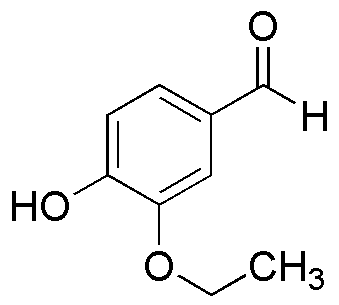Ethyl vanillin (Rhodiarome®) is widely utilized in research focused on:
- Flavoring Agent: Commonly used in the food industry, ethyl vanillin enhances the flavor of various products, including baked goods, chocolates, and beverages, providing a sweeter and more intense vanilla taste compared to regular vanillin.
- Fragrance Component: In the cosmetic and personal care industries, it serves as a key ingredient in perfumes and scented products, offering a rich vanilla aroma that is highly valued for its pleasant scent and ability to blend well with other fragrances.
- Pharmaceutical Applications: Ethyl vanillin is often used in medicinal formulations to mask unpleasant tastes, making medications more palatable for patients, particularly in pediatric formulations.
- Research and Development: In laboratories, it is utilized as a standard in analytical chemistry for flavor and fragrance analysis, helping researchers develop new products or improve existing formulations.
- Food Preservation: Its antioxidant properties can contribute to food preservation, helping to extend the shelf life of products by preventing oxidation and spoilage.
General Information
Properties
Safety and Regulations
Applications
Ethyl vanillin (Rhodiarome®) is widely utilized in research focused on:
- Flavoring Agent: Commonly used in the food industry, ethyl vanillin enhances the flavor of various products, including baked goods, chocolates, and beverages, providing a sweeter and more intense vanilla taste compared to regular vanillin.
- Fragrance Component: In the cosmetic and personal care industries, it serves as a key ingredient in perfumes and scented products, offering a rich vanilla aroma that is highly valued for its pleasant scent and ability to blend well with other fragrances.
- Pharmaceutical Applications: Ethyl vanillin is often used in medicinal formulations to mask unpleasant tastes, making medications more palatable for patients, particularly in pediatric formulations.
- Research and Development: In laboratories, it is utilized as a standard in analytical chemistry for flavor and fragrance analysis, helping researchers develop new products or improve existing formulations.
- Food Preservation: Its antioxidant properties can contribute to food preservation, helping to extend the shelf life of products by preventing oxidation and spoilage.
Documents
Safety Data Sheets (SDS)
The SDS provides comprehensive safety information on handling, storage, and disposal of the product.
Product Specification (PS)
The PS provides a comprehensive breakdown of the product’s properties, including chemical composition, physical state, purity, and storage requirements. It also details acceptable quality ranges and the product's intended applications.
Certificates of Analysis (COA)
Search for Certificates of Analysis (COA) by entering the products Lot Number. Lot and Batch Numbers can be found on a product’s label following the words ‘Lot’ or ‘Batch’.
*Catalog Number
*Lot Number
Certificates Of Origin (COO)
This COO confirms the country where the product was manufactured, and also details the materials and components used in it and whether it is derived from natural, synthetic, or other specific sources. This certificate may be required for customs, trade, and regulatory compliance.
*Catalog Number
*Lot Number
Safety Data Sheets (SDS)
The SDS provides comprehensive safety information on handling, storage, and disposal of the product.
DownloadProduct Specification (PS)
The PS provides a comprehensive breakdown of the product’s properties, including chemical composition, physical state, purity, and storage requirements. It also details acceptable quality ranges and the product's intended applications.
DownloadCertificates of Analysis (COA)
Search for Certificates of Analysis (COA) by entering the products Lot Number. Lot and Batch Numbers can be found on a product’s label following the words ‘Lot’ or ‘Batch’.
*Catalog Number
*Lot Number
Certificates Of Origin (COO)
This COO confirms the country where the product was manufactured, and also details the materials and components used in it and whether it is derived from natural, synthetic, or other specific sources. This certificate may be required for customs, trade, and regulatory compliance.


